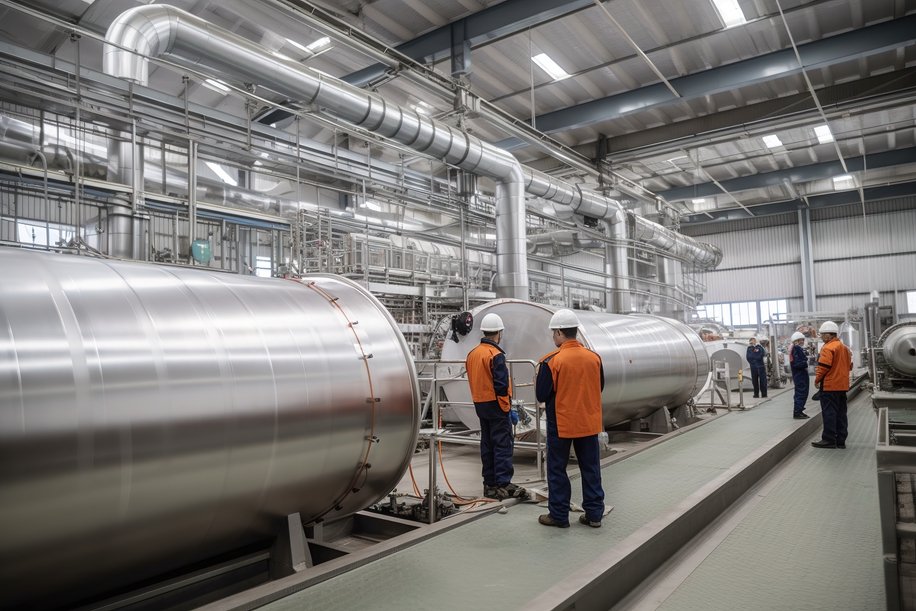British manufacturing: a time to thrive
It’s been a rocky few years for the UK, with Brexit, the pandemic, energy price increases, and changes in government leadership all taking their toll on the economy. But despite many businesses facing turmoil, it’s not doom and gloom for everyone.
British manufacturing is seeing some exciting results and is set to play a key role in the UK’s future growth. With the right investment, government support, and innovation from within the sector, UK manufacturing can overcome many of its challenges and thrive in the post-pandemic, post-Brexit world.
Industry overview
In 2022, the UK held its place as the ninth largest manufacturer globally, with an annual output of £183 billion.
Manufacturing represents 15% of all UK investment, accounts for 9.7% of total economic output and employs over 2.5 million people.
Despite misconceptions that manufacturing is poorly paid, the average manufacturing salary is around 12% higher than the regional average in every region outside London.
64% of all research and development expenditure comes via manufacturing, with the pharmaceutical sector making up over a third (35%) of all manufacturing R&D in the UK.
British manufacturing is a huge contributor to the UK’s economy and creates employment opportunities in every region.


Sub-sector spotlight
While the UK manufacturing industry is strong across the board, some sectors are going from strength to strength.

Food and drink
Food and drink manufacturing is the largest subsector, making up 20% of the UK’s manufacturing industry and contributing £30 billion annually to the economy.
Exports exceed £20 billion and go to 220 countries, with France, Ireland and the USA coming in as the top three destination markets.
There are over 11,000 food and drink manufacturing businesses in the UK, and 97% of these businesses are SMEs. The wider food and drink supply chain is worth £126 billion to the UK economy, and the sector employs 4.2 million people across every part of the UK.
Chemicals
The UK chemical industry comprises over 3500 businesses, directly employing over 150,000 people and supporting an additional 350,000 jobs.
It is one of the highest-paying subsectors, with average salaries of 35% more than other manufacturing industries and 54% more than the average worker.
The sector contributes more than £18 billion of value to the economy from an annual turnover of over £55 billion. It is the UK’s largest exporter of manufactured goods, with over half of exports going to the EU and a further 20% to the US.
The chemical industry accounts for over 20% of the UK’s annual research and development spending.
Automotive
The automotive industry includes specialist car manufacturers, commercial, mainstream and sports car manufacturers, bus and coach manufacturers, design and R&D centres, and over 2500 component suppliers.
It has an average £67 billion turnover, contributes £14 billion in value, and typically invests around £3 billion yearly in R&D.
In 2021, 80% of cars manufactured in the UK were exported to 140 different markets worldwide, accounting for 10% of total UK exports.
The automotive manufacturing industry employs around 182,000 people, with the wider automotive industry employing around 780,000.
Aerospace, defence, and space
The UK’s aerospace industry has a turnover of over £22 billion and exports over £15 billion, contributing £8 billion in value to the economy. It directly employs over 110,000 people, including over 5000 apprentices.
Meanwhile, the defence sector has a £23 billion turnover, average annual exports of £8.8 billion, and adds over £10 billion in value. It directly employs 147,000 people, including 6000 apprentices.
The space sector has a £16.5 billion turnover, exports of over £5 billion and a value add of almost £7 billion. It directly employs 47,000 people, including over 2000 apprentices.

The future of British manufacturing
There’s certainly a lot to celebrate within the industry, but it’s not all sunshine and roses. There are some challenges within the sector, and manufacturers will need to address these head-on if they want to thrive.
But along with the potential threats, there are plenty of opportunities. And if manufacturers are prepared to maximise these opportunities, innovate, and invest, they could see some very exciting developments.
Reshoring
In recent years, we’ve seen an increase in reshoring with manufacturing returning to the UK from across the world. 40% of reshoring is from China, over 30% from Eastern Europe and 20% from India.
Brexit, the pandemic and the war in Ukraine contributed significantly to reshoring when supply chains were heavily impacted, and many companies saw a need to work with more local suppliers.
However, supply chain issues aren’t the only contributing factor. Companies are finding there are several benefits to returning manufacturing to the UK. It’s easier to manage and monitor quality, lead times and delivery costs are lower, and the carbon footprint is significantly reduced.
Reshoring creates plenty of opportunities for UK manufacturers to grow and diversify. It’s a chance to demonstrate to the world what UK manufacturing has to offer regarding technology, innovation, quality, and a large talent pool of highly skilled employees.
Addressing the skill gaps
There are currently over 2.5 million jobs within manufacturing, and the average wage is 12% higher than the economy’s average.
Despite this, there is still a misconception that working in factories is low-skilled, low-paid and dangerous work. Brexit further contributed to staff shortages as there is no longer a free flow of workers coming from the EU.
The industry as a whole must work together, along with the government, to address skills and labour shortages. But what can individual manufacturers do to attract and retain the best talent?
Upskill existing employees: You don’t always have to look externally for great talent – there could be a goldmine of untapped potential right under your nose. Not all employees want to progress, but those who do will become frustrated if they aren’t given opportunities to further their careers. Don’t lose good people. It can be much more cost-effective to upskill existing employees and recruit their replacements than to recruit for senior roles.
Invest in training and development programmes: Create opportunities for your existing employees to learn new skills and develop existing ones. The manufacturing world is evolving, and your employees need to evolve too. If you aren’t proactive in training them for the future of manufacturing, you’ll have an even bigger skills gap a few years down the line.
Mentoring and succession planning: Having experienced employees is all well and good until they retire, and you’re left with huge knowledge gaps. Make sure your senior engineers and leaders are passing on their knowledge to the next generation. Create mentoring programmes and develop succession plans so you aren’t reliant on your long-serving employees to keep you operational.
Apprenticeships: Having experience within your team is crucial, but you also need to invest in young talent. Take advantage of schemes like the apprenticeship levy and inspire young people to pursue STEM careers. Start developing the future talent you need now.
Improve employer branding: There are still many misconceptions about working in factories, making it hard to attract key workers. Make yourself attractive as an employer by showing job seekers what a great company you are to work for. Promote your company values, be visible in the community, and offer more than just a “competitive salary” – make people want to work for you.
Make your company a great place to work: Gone are the days when people left school, got a job and stayed with their employer until they retired. Employees want more from life now, so make your company a brilliant place to work. Invest in your people, offer development opportunities, hold social events, encourage employees to share ideas and concerns, and get involved with local charities. Employees who enjoy coming to work are more likely to stay.
Building a resilient, skilled and engaged workforce will be crucial to the success of the manufacturing industry and the wider economy. Invest in your people, and they’ll be invested in your success.
Transitioning to a net-zero economy
The past few decades have seen an increased focus on reducing carbon emissions, with good reason. The planet is at risk, and we all have a responsibility to protect it. Individuals, businesses and governments worldwide are taking steps to minimise their carbon footprint.
Lowering greenhouse gas emissions, focusing on sustainability and being more environmentally responsible play a crucial role in transitioning to a net-zero carbon economy.
Create more energy-efficient factories: If reducing your carbon footprint isn’t enough incentive to reduce energy use, the rocketing energy prices might well be. Lighting upgrades, voltage optimisation, and installing variable speed drives are simple but effective ways to reduce energy consumption. And with the government’s “super-deduction” in place until April 2023, there’s never been a better time to upgrade your plant and machinery.
Switch power sources: Switching from diesel to electricity, using CHP fuelled by biomass rather than natural gas, or using energy from renewable sources will reduce your carbon footprint. You could even invest in solar panels or wind turbines to create your own sustainable energy source for an even bigger impact and more control over your energy costs.
Embrace electromobility: The move to EV is looking to be inevitable, meaning it’s a case of when (not if) you transition your fleet to EV. Start planning your transition now so it can be rolled out successfully. Start by installing charging points for your employees who have already made the switch or are thinking about making the switch.
Consider the entire product lifecycle: When companies consider their carbon emissions, they tend to look solely at the production of their products, but you need to consider the entire life cycle. This starts with how you are sourcing the raw materials right through to what happens at the end of their life. Are there opportunities to encourage end-users to repair or recycle rather than send it to landfill? Which components can be recycled or reused?
Reuse, reduce and recycle waste products: Recycled plastics are used by hundreds of manufacturers. Bioethanol is being used on a large scale in several companies. Are there opportunities for you to convert your waste into reusable material to use in-house or pass on to other manufacturers?
Collaborate and innovate: Look for opportunities to collaborate with your suppliers, buyers or other manufacturers. How can you work together to make British manufacturing even more energy efficient? Don’t just follow the crowd – be an early adopter. Could your factory be the first to trial new and revolutionary technology? Are you investing in research and development?
Every manufacturer has a part to play in reducing its carbon footprint if the industry is going to achieve net zero.
Maximising available technology
Over the last few decades, technology has advanced at a rapid pace and shows no signs of slowing. This technological revolution has allowed manufacturers to improve efficiency, increase productivity, reduce costs, deliver higher-quality products and boost profits.
There isn’t any area of a business that can’t be enhanced with the right tech, whether it’s customer ordering systems, resource planning or the production lines themselves.
Predictive maintenance and enhanced safety: IoT-enabled devices allow you to monitor and record equipment performance safely, meaning employees don’t need to spend as much time near potentially dangerous machinery. The same technology allows you to collect data insights to help prevent equipment failure or predict outages. You can even conduct monitoring tests while machinery is operational, minimising downtime.
Virtual and augmented reality: Some manufacturers utilise AR or VR-enabled devices to provide remote assistance to customers or satellite sites. Rather than technicians visiting the site to make machine repairs, they can walk a customer or colleague through basic troubleshooting and repair. This means equipment can be back up and running sooner, and technicians aren’t travelling miles to repair minor faults.
3D Printing: Additive manufacturing has been around for decades and is a cost-effective way of prototyping, testing and troubleshooting new products. However, many manufacturers still aren’t utilising 3D printing to its full potential. 3D printing can transform the time-consuming and costly process of tooling, allowing you to create moulds, fixtures and jigs in-house.
Control and automation: Automation and AI are revolutionising the manufacturing industry, reducing waste, eliminating human error, reducing contamination risk and increasing output. Production lines can meet fluctuations in demand without companies having to increase employee headcount or pay excessive overtime. But it’s not just production lines that can be automated. Everything from marketing emails to order processing and stock replenishment can be streamlined and digitised.
Manufacturers looking to grow should utilise the innovative technology available to them. Technology will continue to advance, and those companies that do not embrace digital transformation will get left behind.
Working towards a successful future
As the above outlines, there are many opportunities for manufacturers, and we’re feeling optimistic about the future of the industry.
We look forward to seeing innovative British companies thrive through new green initiatives, sensible investments, and collaborative partnerships. And we’re excited about working with those companies and being part of their success.
At AES, we offer much more than your standard electrical contracting services. We provide specialist services for industrial and manufacturing businesses to help improve productivity, reduce downtime, increase efficiency and lower carbon emissions through energy reduction. Find out more about how we can support your business here.

Link to the infographic file (JPEG)
Link to infographic file (PDF)
Sources:
ONS Blue Book 2021
The Food & Drink Federation (fdf.org.uk)
CIA | Chemical Industries Association
ADS Group
UK Automotive Industry - SMMT

Our guide to building energy management systems
Building energy management systems (BEMS) are systems that allow you to monitor, control, and optimise the energy used within your building. The phrase building energy management system (BEMS) is often used interchangeably with the phrase building management system (BMS), but there are some differences. A BEMS is focused on energy-related systems such as lighting, heating, […]
Read more
How far does power travel and what impact does distance have on performance
It’s easy to take our electricity supply for granted. We flick a switch and instantly have light or power. We don’t even think about it unless there’s an issue or an outage. But when there is an issue or outage, the impact can be significant. For manufacturers, even the smallest change in power can make […]
Read more
Why visibility of the production process is so important
Operational excellence, efficiency and quality are top priorities for almost every manufacturer worldwide. These things lead to improved productivity, happier customers and reduced waste – all of which result in increased profits. Visibility of the production process is the key to achieving these things. And manufacturers now have access to technology that can provide real-time […]
Read more
Will security lighting help to protect my staff?
Looking after the safety and well-being of employees should be a priority for any business. And while it’s not possible to mitigate every risk, there are measures you can take to improve their safety and security. One measure that is often overlooked is the installation of security lighting. When daylight disappears, visibility is reduced, increasing […]
Read more
Top 5 considerations when comparing electrical quotes
Budget is always a factor when you’re considering any type of upgrade, revamp, or maintenance work within your factory. But when it comes to electrical work, you have to consider more than just money. Don’t rush into accepting the cheapest electrical quotes without knowing exactly what you’re getting. Electrical work is not an area where […]
Read more
What is the role of companies in reducing our carbon footprint?
We should all be taking responsibility for protecting our planet and a big part of that is reducing our carbon footprint. But while it falls to all of us to do our bit, there is additional pressure on manufacturers, especially those with high carbon emissions. As an absolute minimum, these companies should ensure compliance with […]
Read more

